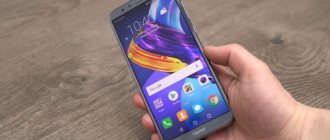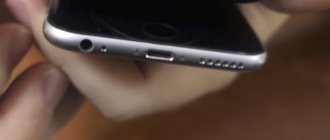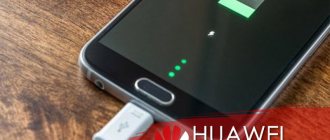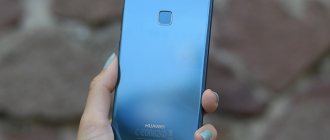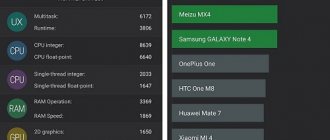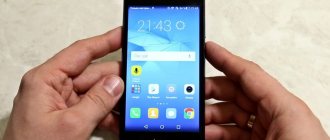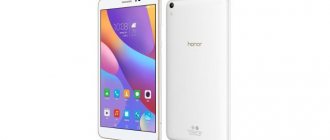Camera and mobility
Gradually, in the more or less calm Android world, not only the difference in the equipment and characteristics of the displays, but also the quality of the camera located on the back of the smartphone became the most important. This becomes especially noticeable when it comes to the top segment. The P20 has a dual camera on the front, consisting of a combination of a 12-megapixel RGB matrix and a 20-megapixel monochrome one. Thus, theoretically, it is possible to obtain photographs with a maximum resolution of 20 megapixels, but in order to talk about good shooting quality, good lighting conditions are required. For this reason, Huawei itself has made the standard resolution 12 megapixels in the settings. We took our test images with the manufacturer's preset settings, and not at the highest possible resolution. Dual LED flash provides plenty of artificial light. In camcorder mode, the P20 shoots at maximum 4K resolution. The setup is complemented by a front camera with a resolution of as much as 24 megapixels. Our experts from the Chip test laboratory rated the resulting photos as very good.
During testing, the P20 camera performed very well
When testing the battery, the P20 currently receives "only" an overall good rating in this parameter. But here, of course, we are talking about comparative characteristics in relation to other smartphone models we tested. Moreover, the results themselves are quite suitable for practical use. The capacity of the easily replaceable battery is 3500 mAh, which is rather average compared to direct Android competitors. Our measurements yielded a very respectable 10 hours of battery life in an “online” scenario, in which we use a specially designed test website with integrated video that reloads every 90 seconds. In this way, we reproduce a scenario for web surfing on a smartphone that is realistic and in line with modern trends. It’s also good that Huawei includes a power supply for fast charging in the P20 package, and the full process of replenishing the battery’s energy reserves takes a tolerable 2 hours.
Since the P20, in addition to everything, deserves praise for its profile of 9.1 mm and a weight of only 163 grams, the autonomy and mobility of this model are at a high level.
Price
A detailed comparison of Huawei P10 and iPhone 7 helps you figure out which model to prefer. The issue of price, as a rule, plays a decisive role.
As for the pricing policy, iPhone 7 does not plan to reduce prices for its releases. Each new gadget that comes out costs several times more than the previous one. This time, the user will have to pay 40,000 rubles or more for the model with the smallest memory capacity of 32 GB. A modification with 128 GB of ROM will cost from 50,000, and the largest device in terms of built-in memory will cost 60,000 rubles. But, oddly enough, despite its rather high prices, Apple has a large number of its fans who watch with bated breath the release of each new version, and often breaks records for pre-orders.
Huawei is much more loyal to its customers when it comes to prices. For the P10 model with the lowest memory capacity of 32 GB, you will have to pay 24,000 rubles, for the average volume of 64 GB the price is at 27,000, and for a smartphone with a memory of 128 GB, the user needs to pay 42,000 rubles. Such affordable prices allow Huawei developers to be leaders in the flagship segment.
Features and test results of Huawei P20
| Price-quality ratio | 68 |
| OS during testing | Android 8.1 with EMUI 8 |
| Current OS | Android 8.1 |
| Is there an OS update planned? | no data |
| App Store | |
| Weight | 163 |
| Length x Width | 149 x 72 mm; |
| Thickness | 9.1 mm; |
| Expert design review | Great |
| Expert assessment of work speed | Very good |
| Download speed: PDF 800 KB via WLAN | 1.6 s |
| Download speed: main chip.de via WLAN | 0.4 s |
| Download speed: chip.de test chart via WLAN | 6.1 s |
| Sound quality (speakerphone) | Very good |
| CPU | HiSilicon Kirin 970 |
| Processor architecture | |
| CPU frequency | 2.400 MHz |
| Number of CPU cores | 4+4 |
| RAM capacity | 4.0 GB |
| Battery: capacity | 3.500 mAh |
| Battery: easy to remove | — |
| Battery: surfing time | 10:07 h:min |
| Battery: charging time | 2:01 h:min |
| Fast charging function | Yes |
| Charger and fast charging cable included | |
| Battery: discharging time/charging time | 5,0 |
| Wireless charging function | — |
| WLAN | 802.11n, ac |
| Voice over LTE | |
| LTE: frequencies | 800, 1.800, 2.600 MHz |
| LTE: Cat. 4 | up to 150 Mbit/s |
| LTE: Cat. 6 | up to 300 Mbit/s |
| LTE: Cat. 9 | up to 450 Mbit/s |
| LTE: Cat. 12 | up to 600 Mbit/s |
| Screen: type | LCD |
| Screen: diagonal | 5.8 inches |
| Screen: size in mm | 64 x 133 mm; |
| Screen: resolution | 1.080 x 2.244 pixels |
| Screen: Dot Density | 429 ppi |
| Screen: max. brightness in a dark room | 444.8 cd/m² |
| Screen: staggered contrast in a bright room | 48 :1 |
| Screen: staggered contrast in a dark room | 139 :1 |
| Camera: resolution | 19.7 megapixels |
| Camera: measured resolution | 1,412 line pairs |
| Camera: expert assessment of image quality | Very good |
| Camera: VN1 noise | 1.1 VN1 |
| Camera: minimum focal length | 4.0 mm; |
| Camera: minimum shooting distance | 7 cm; |
| Camera: Shutter Time with Autofocus | 0.84 s |
| Camera: optical stabilizer | — |
| Camera: autofocus | Yes |
| Camera: flash | Double LED, LED |
| Video resolution | 3.840 x 2.160 pixels |
| Front camera: resolution | 11.8 megapixels |
| LED indicator | yes (multicolor) |
| Radio | — |
| SIM card type | Nano-SIM |
| Dual SIM | Yes |
| Protection against dust and moisture (IP certificate) | — |
| Fingerprint's scanner | |
| User accessible memory | 111.0 GB |
| Memory card slot | — |
| USB connector | Type-C-USB 3.1 |
| Bluetooth | 4.2 |
| NFC | Yes |
| Headphone output | -; |
| HD Voice | Yes |
| SAR | 0.76 W/kg |
| Firmware version during testing | 8.1.0.106 |
| Test date | 2018-03-21 |
Test results
Elegant looks, strong performance and a great camera: during testing, the Huawei P20 proved to be a great smartphone without any major flaws. And although at the time of the test it turned out to be quite far from the Top 10 of our corresponding rating, however, within the premium segment, this device is an inexpensive alternative to the P20 Pro.
Advantages
ease of use very good camera quality excellent display quality chic appearance
Flaws
no memory card slot no 3.5mm audio jack no versions with different memory capacities
Huawei P20 test results
- Price/quality ratio Good
- Place in the overall rating 3 out of 200
- Price/quality ratio: 68
- Performance and Control (35%): 96.5
- Equipment (25%): 91.4
- Battery (15%): 89.3
- Display (15%): 92
- Camera (10%): 90.8
The P20 is powered by the Kirin 970 chip from HiSilicon. Eight CPU cores, four of which are focused on power and four on energy efficiency, operate at a clock speed of 2.4 GHz. They are supported by 4 GB of RAM and a Mali G72 GPU with twelve processing cores. High performance potential combined with a thin EMUI user interface ensures smooth system operation - without any lag.
The built-in storage capacity of 128 GB seems quite large, but if something happens, it cannot be expanded using a memory card. Additionally, Huawei does not offer any other memory configurations. Thus, if you need more space for videos, photo archives or offline music, you will have to use either an external storage device or a cloud service. Since the Huawei P20 is equipped with a USB Type-C interface instead of Micro-USB, flash drives, which have become relatively inexpensive, are not the most suitable option.
The 5.8-inch display occupies almost the entire front side. Only the Notch notch, already known to everyone from the iPhone X, breaks up the display design, leaving room for the front camera, speaker and sensors. During normal operation, information about the mobile network, WLAN and other notifications are located to the left and right of the notch. However, if someone wants to "organize" something like a classic screen frame, the display of black bars can be customized.
The technical characteristics and measurement results of the IPS-LCD panel are excellent. With a resolution of 1080×2244 pixels at its diagonal, the device achieves an image density of 429 ppi (pixels per inch). The display brightness (excluding ambient light) of 445 cd/m2 is good, although noticeably inferior to the record levels of competitors such as the iPhone X and iPhone 8 Plus. In addition, laboratory measurements of the Huawei P20 parameters did not reveal any deficiencies, so at the time of writing this report we can give the display of this smartphone a very good rating.
Display
Sony Xperia H8541
Sony Xperia H8541
Impact-resistant glass (such as Corning's Gorilla Glass) is thin and lightweight and can withstand high levels of impact.
Sony Xperia Z3 16GB
Apple iPhone 11
Huawei P20 Lite
The larger screen size, the better user experience.
Energizer Power Max P8100S
The device has a screen with three whole subpixels per pixel, making images sharp and clear. The pixels in some displays (such as AMOLED) share one sub-pixel to save space. This results in less clear or blurry images.
Apple iPhone 11
Comparison table of flagship cameras
To determine the best photo and video module in this race, it is not enough to read reviews or listen to recommendations from friends. A table that contains the main parameters of the cameras of the three presented devices will help you approach the issue globally:
| Parameter | Samsung Galaxy S9+ | Huawei P20 PRO | iPhone X |
| Main camera | 12 MP | 40 MP + 20 MP + 8 MP | 12 MP + 12 MP |
| Front-camera | 8 MP | 24 MP | 7 MP |
| Flash | There is | There is | Yes, True Tone |
| Stabilization | There is | There is | There is |
| Autofocus | There is | There is | There is |
| Video recording formats | 4K, Full HD | 4K, Full HD | 4K, Full HD |
| Technologies | Super Speed Dual Pixel | 3D facial modeling | Autofocus with Focus Pixels technology |
| Touch focusing and Focus Pixels technology | |||
| Live Photos with Image Stabilization | |||
| Main/front viewing angle | 77°/80° | n/a | n/a |
| Panorama | There is | There is | There is |
| Professional mode | There is | — | There is |
| Interesting modes | Super Slow-mo mode, up to 720p, 960 fps | 5x hybrid zoom | Optical zoom; 10x digital zoom |
| Hyperlapse | Slow motion 960 fps | Portrait mode | |
| Food mode | Portrait lighting | ||
| Selective focus | Quad-LED with Slow Sync | ||
| VDIS (Video Digital Image Stabilization) | Expanded color range for photos and Live Photos | ||
| HDR (High Dynamic Range) | Face and shape recognition | ||
| Exposure control | |||
| Noise suppression | |||
| Automatically enable HDR when taking photos | |||
| Continuous shooting | |||
| Timer mode | |||
| Linking photos to the shooting location | |||
| Image formats: HEIF and JPEG |
Cloudy day, bright colors
The very first frame – and immediately disappointment in the Chinese flagship.
When shooting against a fairly light sky, the Huawei P30 Pro camera tries to darken the image as much as possible, failing to cope with the contrast. Yes, the sky turned out better, but at the cost of overall darkening of the image.
The iPhone 11 Pro conveyed the colors of the statue as truthfully as possible, sacrificing the color of the sky - it simply falls into a pure white background. In both cases, I tapped on the screen, focusing specifically on the statue.
Both smartphones handle bright colors differently. Huawei simply twists the colors, so the photos turn out too juicy.
Some people like this particular color rendering; in Asian countries they like eye-catching colors. But this is strictly not for everyone.
The iPhone, on the other hand, takes photos with an eye-pleasing warmth. It’s nice to look at this shot and there’s no blood flowing from the eyes.
Although, in Huawei's defense, I can say that in real life the colors were just that bright, so in terms of truthfulness, the P30 Pro did a better job.
I suggest you guess the next pair of photos yourself, which pigeon was photographed on the iPhone 11 Pro, and which on the Huawei P30 Pro. Choose with your heart!
Each photo was taken with 5x zoom.
And here is the crop, compare:
Options:
- Photo No. 1 - iPhone, No. 2 - Huawei
- Photo No. 1 - Huawei, No. 2 - iPhone
56%
Photo No. 1 - iPhone, No. 2 - Huawei
44%
Photo No. 1 - Huawei, No. 2 - iPhone
340 voted
The correct answers will be at the end of this article, don’t look ahead 
Here are some more bright colors on a neutral green background. I like the iPhone photo better:
And in the next photo, Huawei went crazy, remembered rave parties and came up with something completely absurd. This is what the world looks like on ultra settings in Chinese:
Huawei P30 Pro
The same flower, but performed by the iPhone 11 Pro, looks much more natural and natural:
Let's face it: both smartphones take great photos, but each has its own signature.
If Huawei constantly tries to correct the white balance and often makes mistakes, then the iPhone copes with this task much more professionally:
In general, in daylight, both smartphones cope well with photography. My subjective opinion is that Huawei’s beautifier does more harm than good. iPhone 11 Pro photos capture colors more accurately and blur backgrounds more beautifully.
Let's move on to the width.
Design
The device is dustproof and waterproof. Water-resistant devices are protected from water penetration, such as from powerful water jets, but not from immersion in water.
Apple iPhone 11
Huawei P20 Lite
The device is protected with additional insulation to prevent damage from dust, rain and splashing water.
Apple iPhone 11
Huawei P20 Lite
Asus Zenfone AR 64GB
Vertu Signature for Bentley
Display
Sony Xperia H8541
Sony Xperia H8541
Impact-resistant glass (such as Corning's Gorilla Glass) is thin and lightweight and can withstand high levels of impact.
Sony Xperia Z3 16GB
Apple iPhone 11
Huawei P20 Lite
The larger screen size, the better user experience.
Energizer Power Max P8100S
The device has a screen with three whole subpixels per pixel, making images sharp and clear. The pixels in some displays (such as AMOLED) share one sub-pixel to save space. This results in less clear or blurry images.
Apple iPhone 11
Huawei P20 Lite
IPS (In-Plane Switching) is a technology used for LCD displays. It was developed to overcome the main limitations of conventional curved nematic TFT displays, such as limited viewing angles and poor color quality. PLS (Plane Switching) is a type of IPS screen developed by Samsung with higher brightness and lower cost.
